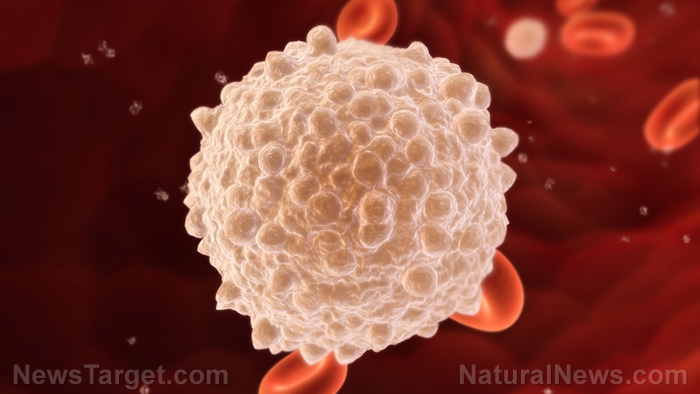
Eosinophilia – causes, side effects and treatments at NaturalPedia.com
Tuesday, March 20, 2018 by Ralph Flores
http://www.naturalpedia.com/eosinophilia-causes-side-effects-and-treatments-at-naturalpedia-com.html

Eosinophils are white blood cell subtypes which protect the body against infections, as well as increase its immune response. Conversely, the white blood cell types also contribute to inflammation.
There isn’t a lot of eosinophils in the body; however, this may increase in response to allergic disorders, skin conditions, parasitic and fungal infections in the body, autoimmune disorders, certain types of cancers, and bone marrow disorders. Some cases have seen eosinophils move outside the bloodstream and accumulate in organs and tissue cells.
This increased number of eosinophils in the body is called eosinophilia. While a slight increase in number does is asymptomatic, abnormally high amounts can lead to organ damage as well as pain in the area. To note, eosinophilia is characterized as:
- Mild: 500 to 1,500 cells per microliter of blood
- Moderate: 1,500 to 5,000 cells per microliter of blood
- Severe: above 5,000 cells per microliter of blood
An uncommon disorder, idiopathic hypereosinophilic syndrome (HES), happens when the number of eosinophils goes up to more than 1,500 cells per microliter of blood with no underlying cause. This condition is seen in males above 50 years, but it can occur at any age. Left untreated, it can kill a person in less than two years.

Known risk factors and symptoms of eosinophilia
The causes of eosinophilia can be summed up by the mnemonic CHINA, a shorthand for diseases linked to the condition.
- Connective tissue diseases affect tissues which connect and support most organs of the body.
- Helminth (or worm) parasites include both roundworms and flatworms that infect the body.
- Idiopathic HES have no known causes.
- Neoplasia is the condition where cells grow uncontrollably. This could either be benign or malignant (cancerous).
- Allergic or atopic conditions include asthma and allergic rhinitis.
Symptoms of eosinophilia differ according to the condition; however, when combined with end-organ damage, it will result in blue or purple toes.
Body systems affected by eosinophilia
The condition is normally found together with other complications, but it still primarily affects the vascular system.
Food items or nutrients that may prevent or relieve eosinophilia
Having a healthy lifestyle and taking a proper diet may greatly reduce the chances of eosinophilia. Still, here are some recommended food items to help manage the condition.
- Neem juice – A famous medicinal tree in India, neem has shown antimicrobial properties which can be used to treat microbes and pathogens in the body. While neem juice can taste unpleasant, supplements are available which are easier to swallow. Aside from its antimicrobial properties, neem juice can detoxify the blood and support the body’s immunity.
- Black pepper – Another spice popular in the Indian subcontinent, adding two to three teaspoons of black pepper with honey and mixing it with hot water can help reduce inflammation in the body. It can also aid in better skin and provide immune support.
- Holy basil – A silver bullet in ancient Indian medicine, the herb is known to treat diseases from diabetes to asthma, and even blood-related diseases. For people with eosinophilia, the root is helpful: Use the dry powder made from the root or add it to tea to attenuate allergies.
- Turmeric – In powder form, turmeric is known to be anti-inflammatory and anti-cancer, which is beneficial for managing eosinophilia. To lower its levels in the body, drink turmeric tea regularly.
- Ashwagandha – Also known as Indian ginseng, it contains natural antimicrobial, anti-inflammatory and anti-allergic properties which can greatly reduce the eosinophil count with regular use.
Treatment and management options for eosinophilia
Eosinophilia is usually treated based on the underlying condition that accompanies it. In the event of idiopathic HES, corticosteroids are sometimes given to lower the eosinophil count.
Where to learn more
- Genetically modified organisms inject DNA into intestinal bacteria
- Tartrazine is not just a food colourant
- How the ‘Discoverer’ of ‘AIDS’ in 5 Gay Party Boys from 1981 Made the Biggest Blunder in History
- Medicine.news
- Health.news
Summary
This increased number of eosinophils in the body is called eosinophilia. While a slight increase in number does is asymptomatic, abnormally high amounts can lead to organ damage as well as pain in the area. It usually is found together with other complications, but it still primarily affects the vascular system.
There isn’t a lot of eosinophils in the body; however, this may increase in response to allergic disorders, skin conditions, parasitic and fungal infections in the body, autoimmune diseases, certain types of cancers, and bone marrow disorders. Some cases have seen eosinophils move outside the bloodstream and accumulate in organs and tissue cells.
Sources include:
Tagged Under: Tags: eosinophilia





